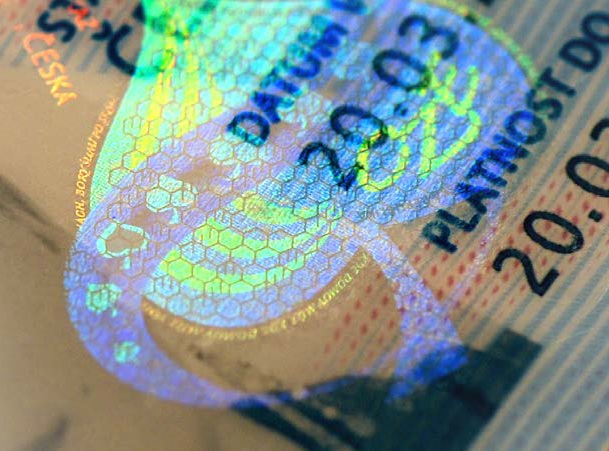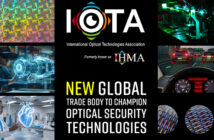
Incidences of fake driver’s licenses in the US and reports by China’s state run Xinhua news agency that 40% of items sold online in China are either counterfeit or of bad quality, reiterate that the battle to beat the criminals, particular those involved in ID counterfeiting, remains to be won. However, governments, security agencies and brand owners are fighting back with the latest in advanced hologram technology says Dr Mark Deakes, general secretary of the International Hologram Manufacturers Association (IHMA), who looks at the latest developments.
Over the last 30 years, since they first appeared on UN passports, holograms have made rapid gains in ID anti-counterfeiting, moving initially from an authentication device to the protection of personal bio data contained within the passport. This has been further underpinned by the EU which saw adoption in 2004 of its draft security standards for passports. This saw incorporation with EC Resolution No 2252/2004 for minimum standards, stipulating that ‘An optically variable (OVD) or equivalent device, which provides the same level of authentication and security as currently used in the uniform visa format, shall be used on the biographical data page and shall take the form of diffractive structures which vary from different angles incorporated into the hot-sealed or an equivalent laminate (as thin as possible) or applied as an OVD overlay, or stickers on a non-laminated paper inside page (as metallised or partially demetallised OVD with intaglio overprinting) or equivalent devices’.
 Another major driver for the inclusion of holographic technology on ID documents came when the ICAO (International Civil Aviation Organisation) specified in 2002 that passports should feature optically variable devices like holograms to combat counterfeiters, particularly in the wake of 9/11. MRTD (Machine Readable Travel Documents) of ICAO Doc9303, Part 1 Passports, 6th Edition. This states that ‘When the biographical data page of a passport book is protected by a laminate or overlay, an optically variable feature (preferably based on diffractive structure) should be integrated into the page. Such a feature should not affect the legibility of the data…The inclusion of a diffractive optically variable feature is recommended to achieve an enhanced level of protection against reproduction’.
Another major driver for the inclusion of holographic technology on ID documents came when the ICAO (International Civil Aviation Organisation) specified in 2002 that passports should feature optically variable devices like holograms to combat counterfeiters, particularly in the wake of 9/11. MRTD (Machine Readable Travel Documents) of ICAO Doc9303, Part 1 Passports, 6th Edition. This states that ‘When the biographical data page of a passport book is protected by a laminate or overlay, an optically variable feature (preferably based on diffractive structure) should be integrated into the page. Such a feature should not affect the legibility of the data…The inclusion of a diffractive optically variable feature is recommended to achieve an enhanced level of protection against reproduction’.
Big business
Identification documents are big business, worth hundreds of millions of dollars a year to designers, producers and suppliers of passports, driver’s licences and pass cards, and is driven by events such as 9/11, increased security in the wake of the threat of increased global terrorism, a more transient and migratory population and the need for better and more effective identity confirmation for all types of access or services. Today, holography remains a security feature of choice to secure the critical personal data in a passport (Keesing Reference Systems estimated back in 2012 that more than 55% of passports use an OVD [optically variable device]to protect data, and of this 67% were DOVIDS) or an ID card against interference, tampering, alteration, forgery or counterfeiting.
 The overall production of passports, which is currently estimated to be upwards of 300 million per year, may fluctuate, but undoubtedly continues to grow as populations increase, and more and more people travel abroad. This allied to the fact that all ICAO member countries must now issue MRPs with ICAO recommending the use of OVDs, all but guarantees a growing market for a security holography industry that has moved to meet the challenge thrown down by those with responsibility for producing and administering ID over the last 13 years with a range of high quality, state-of-the-art, benefits-led security products for all types of documents, which perform to high standards…Click HERE to find out more about this article
The overall production of passports, which is currently estimated to be upwards of 300 million per year, may fluctuate, but undoubtedly continues to grow as populations increase, and more and more people travel abroad. This allied to the fact that all ICAO member countries must now issue MRPs with ICAO recommending the use of OVDs, all but guarantees a growing market for a security holography industry that has moved to meet the challenge thrown down by those with responsibility for producing and administering ID over the last 13 years with a range of high quality, state-of-the-art, benefits-led security products for all types of documents, which perform to high standards…Click HERE to find out more about this article





